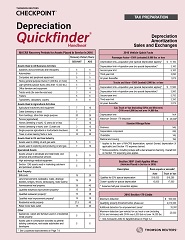We're available Monday to Friday from 8 a.m. to 6 p.m. eastern time.
Need help right now? Call 1-800-431-9025.

The 2025 Depreciation Quickfinder Handbook will be available in December 2025. Pre-order your Handbook today.

The Depreciation Quickfinder Handbook is your trusted source for quick reference solutions to help you determine the right recovery period, compute the right amount of depreciation, decide whether expenses need to be capitalized, manage the special rules for autos and other listed property, claim the Section 179 and bonus depreciation deductions, correct depreciation errors, work with like-kind exchanges and involuntary conversions, and simplify a host of other complex tax issues. It provides quick answers to all your business property questions in a concise, easy-to-use format.
For tax professionals who need more information on business property issues, this Handbook is the perfect companion to the widely relied upon 1040 and Small Business Quickfinder Handbooks. It concisely explains how to handle business property issues on tax returns, and how to plan business property transactions for optimal tax results.
The Handbook gets you the accurate answers you need quickly with:
See information above for new edition availability. To order the current or prior tax year editions, please call us at 800-431-9025.